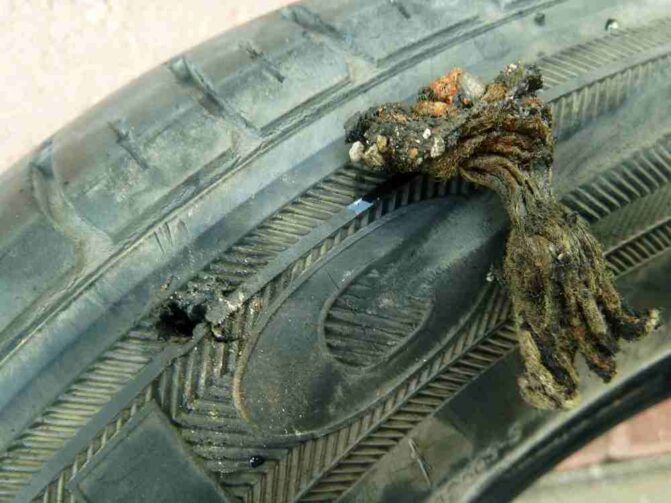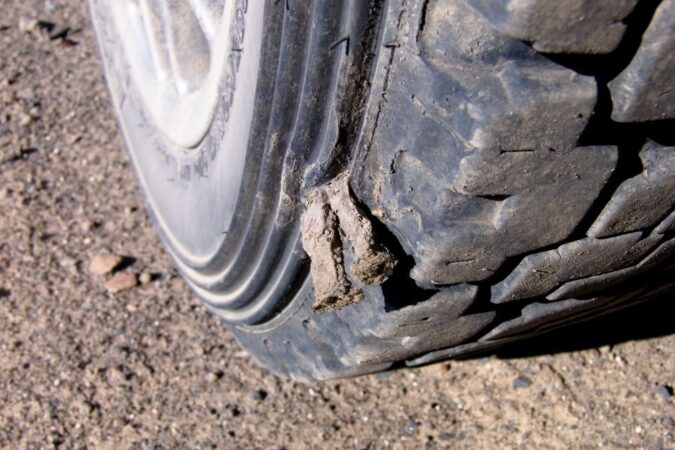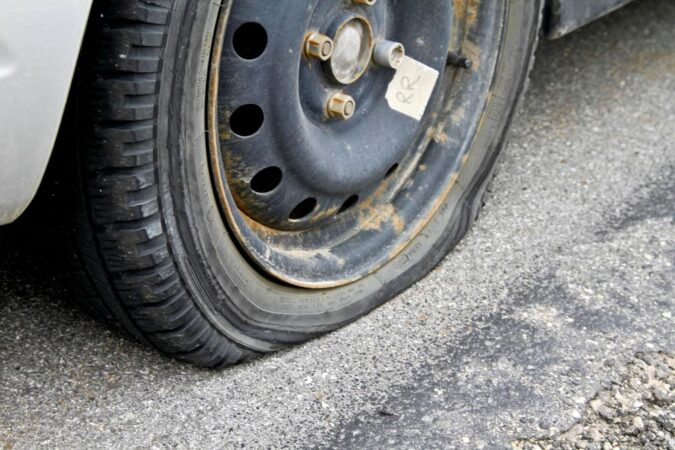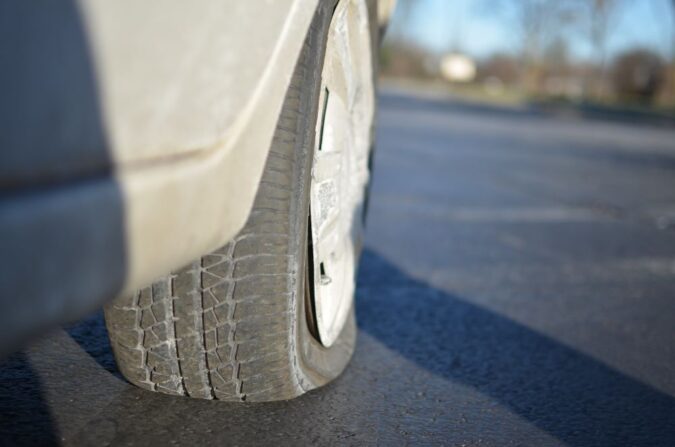Modern-day cars are designed to be tough, resisting the pressures of rough terrain and extended hours of driving. The issue, however, is that tires are not meant to last forever. There will be leaks in them every so often, and that leak can develop anywhere on the tire. The leak’s location will determine whether it’s fixable or not. A tire can either be tubed or tubeless and that affects the answer as well. Only tubeless tires are repairable with the technique of plugging. But how long does a plugged tire last?
We have all been there. You walk up to your car, hoping to drive it to get to your designated location only to see a flat. Disappointment fills your heart as you stare at the stray nail lodged inside one of the tires. But the nail is small, so you consider plugging the tire and going on with your life.
This is our topic of discussion today. Is plugging a tire a good decision? If yes, how long does a plugged tire last? We will also show you how to plug a tire. Keep reading to find out more.
- What Is A Tire Plug?
- Longevity Of Tire Plugs
- Risks Of Driving With One
- Tire Plug Or Patch?
- When You Should Not Plug
- How To Plug A Flat Tire?
- Tire Care And Maintenance
Tire Plug
A tire plug is a ductile, extended piece of rubber that is inserted inside the puncture of a tire’s exterior. It will expand inside and stop air from getting out. Tire plugs can be installed in very little time and you don’t even have to remove the tire from the wheel. In some cases, it can also be done when the tire and the vehicle are connected.
In addition, a tire plug is quite cheap. Many people love a tire plug and swear it can last for ages. However, there are conflicting opinions on this “quick fix.”
How Long Does A Tire Plug Last
According to tire experts, a properly plugged tire can last anywhere between seven to ten years. Generally, tire plugs tend to last a long time, but you should never plug or patch a tire more than once. It can reduce the speed rating and increase the risks of a blowout.
“The Plug is Holding!” by treedork is licensed under CC BY-NC-SA 2.0 .
If your tire gets punctured and needs to be repaired, consult your nearby tire service center and let them tell you what kind of repair is required and what is best to expand the lifespan of your car’s tires.
Can I Drive Long Distance With A Plugged Tire
Plugs are meant to be a temporary solution until they can be replaced properly. We get it. Life happens. A few days turn into a month, then multiple months before you remember that you were supposed to get the tire fixed about a year ago. That is when you start to wonder: Is it safe to drive on plugged tires?
As it turns out, plugging a tire can have serious repercussions on the integrity and life of the tire. This is what you should know about plugged tires and the safety they offer during drives.
1. It Is Only Okay To Plug A Tire In Particular Scenarios?
Before asking yourself how long does a plugged tire lasts, it is important to consider whether it is even safe to install a plug, to begin with. There are certain instances when it is safe to do so. Apart from that, driving on plugged tires could be a health hazard for you as well as other passengers on the road.
Based on the dimensions of the puncture, the tread of the tire, and the severity of the damage, the tire may not even be applicable for a plug. The size of the damage (hole) should be no larger than 6.35 mm and must be situated on the tire’s tread. If the puncture exists on the sidewall or shoulder, you have to replace the tire.
Moreover, the angle of the hole also plays a deciding factor in the plug’s effectiveness. Ideally, whatever damaged your car’s tires went straight in and that makes the fix fairly straightforward. However, if the puncture is leaning toward an angle, you will have a hard time sealing the hole properly. Take note of the angle the screw entered the tire and how it looks in there.
The quality and age of the tire are two of the relevant factors. In case the tire’s tread has been worn under 1/16 of an inch, know that the tread cannot be plugged. Now you might be wondering what a weird measurement the 2/32 or 1/16 of an inch is. You can use the classic penny test to figure this out.
You must make sure the tire passes the test before you start thinking about how to plug it. Any tire that fails this test has to be replaced anyway.
2. Risks Of Voiding The Tire Warranty
One more thing to keep in mind while driving on plugged tires is that it may have an impact on the warranty provided by the manufacturer. Improper maintenance and repair are more than enough to void the warranty. So next time you plan on conducting a DIY operation on your car to save some money, think twice as you may end up costing yourself more in the long run.
When it comes to tire and vehicle safety, we always suggest leaving things up to professionals. The case is different when you have certain experiences with cars and are well-equipped to handle slightly inconvenient situations. By having the tire fixed by a professional, you have the peace of mind that the job was done correctly without jeopardizing your warranty.
3. Delaying The Fix
What’s the biggest issue with plugging a tire? A concerning number of drivers forget that the reason there is a plug in the tire is that there is a puncture there. The plug is only meant to be a temporary fix – a structural failure still exists in your tire and that has to be addressed.
It goes without saying that a plugged tire is not capable of handling the same level of strain and stress as a tire in decent condition. You can easily notice the difference when you accelerate on highways. Once it has been repaired, the manufacturer will not support the speed rating of a tire. A plugged tire is not compatible with plans of racing or off-roading.
Over time, the small puncture will keep growing, resulting in greater air loss. Ultimately, the chances of a blowout sharply increase. Furthermore, the plugging can fail mid-drive, kicking you back to your starting position.
4. A Change Of Tires Would Do You Better
In the event that your tire got flat due to a screw of a nail, we strongly recommend replacing the tire(s). A patch or plug is meant to serve as a temporary Band-Aid till you can get it replaced – don’t think it will hold on forever.
While you may be tempted to see how much value you can wring out of a $5 repair, a plugged tire failure brings consequences that far outweigh the cheap cost-benefit. If you recently bought a set of tires or a single one, this can be an annoying experience. Don’t hesitate to reach out to a certified professional – the tire(s) may still be salvageable.
Tire Plug Vs Patch
It is important to understand the difference between patching and plugging a tire. Keep in mind that in some scenarios, neither of these solutions will help, so you will have to look into the final resort – replacing the tires.
Some repair specialists claim there is an option better than plugging – a radial patch. Named after radial tires, radial patches are best suited for the tires used the most on today’s roads. You can patch a tire using a radial patch in under 30 minutes. On the other hand, plugging a tire takes a few minutes and can be done even when the wheel is attached to the car.
Occasionally, the tire patch has to be vulcanized before the fix. Vulcanizing is using heat in combination with curing agents to secure the tire’s rubber.
1. What Is A Radial Patch?
A radial patch is a piece of rubber that has to be laid flush against the inside of a tire and technically, that repairs the damage. For this to work, you have to remove the tire from the vehicle and wheel.
Once that’s done, the patch is put on over the tear or puncture. As the tire gets its air pressure back, the patch widens and merges with the rubber, making a solid piece. As mentioned before, this process is a bit lengthier than plugging a tire.
2. So, Which is Better?
There is way too much conflicting information and opinions on tire plugs versus tire patches, so it is difficult to boil it down to one definite answer. We would say that the choice depends on you. Both are meant to repair and maintain a tear or puncture in the tread of the car’s tires.
Sometimes, a radial patch can repair sidewall damage. However, in theory, sidewall damage is a sign that the tire(s) must be changed immediately.
The keyword here is ‘repair’. When you are putting a plug or patch in your tire, you are not technically repairing it – you are buying yourself time before the actual fix. What we are trying to say is that you should always note that tire damage has to be fixed. Even if air pressure is retained in the tire, but there is a small leak, inspect it. After all, small damages slowly build you up to disastrous ones.
Tires have to be examined and maintained regularly for wear and tear, damage, and lifespan.
When Can A Tire Not Be Patched
Not all tires are pluggable or patchable. When exactly should you refrain from plugging a tire?
- If the puncture was caused by a blunt object like a nail, glass, or sharp metal bits. As long as the tear or puncture is on the tire’s tread and not the actual wall of the tire, it can be repaired.
- You cannot install a plug or patch in a tire with holes on the sides of the wall. This is when you have to purchase a brand-new set of tires. Although it is expensive, it is best to put safety first.
- Are you dealing with multiple punctures at the same time? Depending on the distance between the damages, the tire can either be plugged or fixed. If the damages are less than 16” apart, a new tire is a given.
- If the tire has developed serious damages causing it to get large cuts or tread separation, it is high time to throw those out.
How To Plug A Tire
If there is a leak where the rim of the wheels meets the sidewall of the tire, that is termed a “bead leak.” Bead leaks cannot be repaired without a mechanic, as there are crucial elements involved, such as dismounting the tire, and remounting it after an application of sealing liquid to the bead. You can attempt plugging a tire if the puncture is on the side of the tire.
The total time to complete the repair should not exceed 15 minutes. Doing the repair by yourself, you can save around $20 plus the time spent bringing the car to the mechanic.
Be careful though! Do not try to do the repair if you have no experience fixing minor issues with your car. Trust us, you don’t want to put yourself at risk over a few dollars. The effectiveness of the plug largely depends on how well the job is done. Don’t be surprised if the plug falls loose after a few days due to a subpar job done (by you!).
Tools Required
- Pliers
- Carjack
- Tire plugging kit
- Spray bottle
- Wire cutters
Materials Required
- Water and soap solution
- Paper towels
- Tire sealing cement
- Tire plug strips
“Flat tire” by markrabo is licensed under CC BY-NC-SA 2.0 .
Steps To Installing A Tire Plug
Here’s what you need to do to install a tire plug…
1. Locate The Leak
- Fill out the tire by pumping enough air into it. It should be firm.
- Closely examine the tire to locate the leak. At this point, you do not have to remove the tire from the vehicle, but you might find it easier if you use a car jack to lift the vehicle. This takes the weight off the wheel and allows rotation.
- Prepare a 20% soap and 80% water solution and put it in a spray bottle. Spray the wheel methodically if the leak is not obvious. Where there is a leak, there will be bubbles forming.
- Use pliers to take out any screw, nail, or stray metal object that is lodged in there.
2. Ream Puncture Hole
- Push the T-handle reaming tool inside the hole before working it up and down numerous times – all while rotating it. It will widen the hole and clear up the inner surface so it receives the plug better.
- Pull out the tool and inspect the hole. If it is not completely uniform and round, reinsert the tool and continue working it up and down a few more times.
- With tiny punctures, sometimes the reaming tool can’t be inserted. Alternatively, you can use a hand-held drill. Choose a drill bit a bit smaller than the reaming tool’s diameter. Use the bit and drill to enlarge the puncture, followed by the reaming tool to roughen the sides up.
3. Ready The Plug
- Get a plug strip from the tire plugging kit and thread it through the plug insertion tool’s eyelet. Pull it through the other side of the eyelet with the pliers until the plug strip is equally distributed on both sides.
- Layer tire sealing cement over the entire plug strip and repeat with the puncture in the tire.
4. Insert The Strip
- Slide the insertion tool into the puncture slowly. If it is resisting, don’t worry; just keep pressing as hard as you can.
- Insert the plug deep enough so only about 1” of it is outside the tire. Then, gently push the tool’s handle upwards. The plug will stay in the tire while the tool itself will slide right out.
5. Pump The Tire
- Attach the tire to a pump or air compressor, and fill it with air just under the 10% maximum rated pressure.
- Use the soapy solution once more so there is no leak.
6. Trim The Excess
- With a paper towel, wipe off the additional sealing cement around the plug
- Allow the tire to rest for 5 minutes.
- Snip off most of the excess plug with wire cutters. Leave about 1/8” sticking out.
7. Conduct A Final Leak Test
- Observe if bubbles form when the plugged area is sprayed with water. If there is none, you did it right and the plug is sitting properly.
- Lower the car, extract the jack, and you can resume driving right away.
Opinions vary on whether or not a plug repair is temporary, but some mechanics term it as a once-and-for-all fix. But it is still recommended that you get the tire fixed.
Tire Care And Maintenance
Tires are a crucial part of the vehicle. They are what keep the car on the road. This is why it is confusing when many people claim they don’t conduct regular maintenance on their tires. New drivers generally believe that as long as the car has gas, and you replace the oil immediately after the CEL comes on, you should be fine.
“Getting a Flat Tire” by Michael Kappel is licensed under CC BY-NC 2.0 .
While no one can deny the importance of engine maintenance, you also cannot disregard the necessity of healthy tires.
How Long Does A Plugged Tire Last, Maintenance Tips #1: Inspecting The Tires
Tire inspection should be done once a month. However, if you drive long distances frequently, reside in a colder climate, or move on rough terrain, the inspection has to be done once every 2 weeks. Luckily, examining tires only takes about a few minutes – if you know what to look for.
How Long Does A Plugged Tire Last, Maintenance Tips #2: Wear And Tear
The majority of the tires’ problems can be troubleshot by simply observing them. You can tell if they are underinflated, overinflated, or poorly aligned by just one glance. Here’s how you know:
- Under Inflation: When the tires don’t have enough air in them, the sides sag, wearing the edges out much faster than the tire’s center. This is amongst the most common reasons behind tire failure.
- Over Inflation: Tires that have too much air in them have middle sections that bulge. That wears down quicker than the edges or sides.
- Poor Alignment: A car out of alignment has tires that display peculiar problems. A side of every tear wears down faster than the rest.
How Long Does A Plugged Tire Last, Maintenance Tips #3: Calculating The Tread
In order to retain traction and keep the vehicle on the road, tires require tread. The tread is what keeps the car from sliding around when you are driving through a puddle in the rain.
When checking the tread, you have to look for depth. The penny trick is a super easy and popular method used to measure tread depth. AAA, however, suggests drivers switch out the penny for a quarter for precise measurement.
How Long Does A Plugged Tire Last, Maintenance Tips #4: The Quarter Trick
Push a quarter headfirst into the tire’s tread. If the head of George Washington is visible, the tire tread is worn out and has to be changed. Do this measurement in three places across the head of the tire – inner edge, center, and outer edge (if there is an inflation issue too).
How Long Does A Plugged Tire Last: Things To Notice While Driving
You can troubleshoot tire problems while you are driving. Watch out for these signs.
1. Rumbling Or Thumping
If something feels off about your tires, there is probably a problem. Unusual sounds or feelings are the first giveaways. A radial belt might have detached, or the tire could be chopped, as well as a number of other problems. If that happens, stop the car and perform the examinations given above.
2. Pulling
The wheel alignment might be off if your vehicle pulls to a side without any actions from your end. You have to check this checked with a professional immediately as it could end up creating more problems down the line.
Tire Repair Facts:
- Tire plugs are strips of leather covered in a rubber compound that are inserted into small holes and typically seal on the inside of the tire.
- Tire patches are pieces of rubber with an adhesive back that are stuck onto the inside of the tire and are stronger than plugs but require more work.
- Tire plug-patch hybridizes both.
- Plugs are used on small holes away from the sidewall, while patches are better than plugs for bigger holes, holes closer to but not the sidewall, and holes that aren’t completely straight.
- Don’t plug or patch your tire if it’s near the sidewall, has an irregularly shaped hole, is a large hole or thick nail, has damaged sidewalls, or is bordering another repair.
- If you’ve run the tire while it was flat for more than a mile, the sidewalls may be damaged and you should not plug the tire.
- A tire should be removed from the wheel and checked for other holes/issues before being plugged or patched.
- Both properly installed plugs and patches can last from seven to ten years or the rest of the tire’s life, but it depends on the installation and location of the hole.
- Tires should be frequently checked and replaced, and repairs should follow safety standards set by the US Tire Manufacturers Association and the Tire Industry Association.
- Tire repair should be left to a local expert in most cases, and DIY repairs are not advisable unless the situation is very straightforward.
How Long Does A Plugged Tire Last: In Conclusion…
How long does a plugged tire lasts largely depends on your driving and the state of the tire. What we can tell you is that it’s not quite safe to drive with a plugged tire.
Plugging should never be the end solution. When you start considering a temporary repair as a permanent one, chances are, there will be repercussions. Proper tire maintenance can also extend how long a plugged tire lasts.




